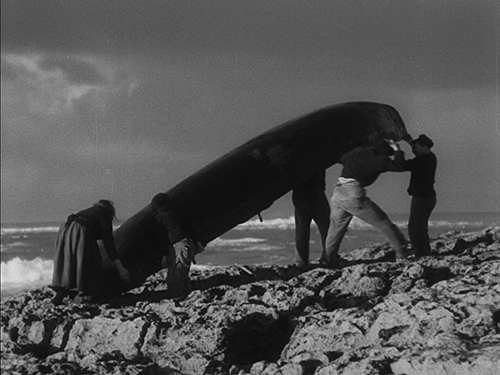
Man of Aran (1934) is a documentary film on life on the Aran Islands off the western coast of Ireland. It portrays characters who live in premodern conditions and their hardships, documenting their daily routines such as fishing off high cliffs, farming potatoes where there is little soil, and hunting for huge basking sharks to win their liver oil for lamps.
“Man of Aran is dominated by the ocean. Waves fill the screen, edited in quick cuts, intensifying the sense of peril. Foam bubbles across the shore like spilled milk, in whorls and whirlpools of white against the black rocks. At times, it seems like the camera will be submerged. There are long shots of Inishmore’s Western coast, the cliffs battered by monster waves. I was on Inishmore years ago, deep into off-season, walking around on the cliffs, spray from hundreds of feet below exploding over me. Staggering back to the car, soaked, I thought of Synge’s description: ‘So much spray is in the air that a soft crust forms on the pages of the notebook where I write.’ Flaherty captures this.
Flaherty was drawn to people seemingly untouched by progress. Realities that did not cooperate with his romantic views were left out. For example, the Inuit people in his 1922 surprise hit Nanook of the North were far more connected to the modern world of Canadian commerce than the film suggested. As Seán Crosson of the Huston School of Film and Digital Media remarks in A Boatload of Wild Irishmen, a documentary about Flaherty, ‘[Flaherty] had clearly been influenced by the Irish literary revival of the late 19th century. But it’s possible life on Aran was never like that. Perhaps it only existed in Flaherty’s mind.’ Often filmed from a low angle, the characters tower into the sky, idealized peasants, like ‘workers’ in a Soviet propaganda poster. When the Man swings a mallet over his head to crush rocks in the fields, his moves are punctuated with dramatic chords in the score by John Greenwood. He becomes an iconic representation of man in his natural state.”
Sheila O’Malley1
« Dans L’Homme d’Aran (1934), Robert Flaherty suppose, hypothèse, que le monde resterait fragmentation et chaos, menace et mort, s’il n’y avait le cinéma. Qu’en est-il de ce qu’on appelle ‘documentaire’ ? Que nous apprend la pratique de celui qui passe pour avoir fondé le genre ? Perdu sur son île qui est en même temps salle de montage et labo, Flaherty se demande jour après jour si, pour lui, la seule ‘réalité’ n’est pas la réalité filmée, si, autrement dit, la robe sans couture de la réalité ne devient pas au cinéma collage des lambeaux innombrables du manteau d’Arlequin? Montage, illusion, croyance: le spectateur est aveuglé par ce qu’il voit, alors que le cinéaste ne croit que ce qu’il filme. Cela donne un film enragé, où s’oppose à la violence du vent, des tempêtes, des requins, des pierres mêmes, la non moins grande violence des images. Encore une fois, l’impossibilité technique (et pratique, en l’occurrence) de prendre du son direct synchrone ouvre à une démultiplication des puissances du montage. »
Jean-Louis Comolli2
- 1Sheila O’Malley, “TCM Diary: Man of Aran,” Film Comment, March 6, 2019.
- 2Jean-Louis Comolli, Voir et pouvoir. L’Innocence perdue : cinéma, télévision, fiction, documentaire (Paris: Éditions Verdier, 2004).

